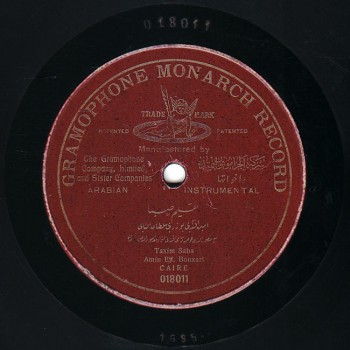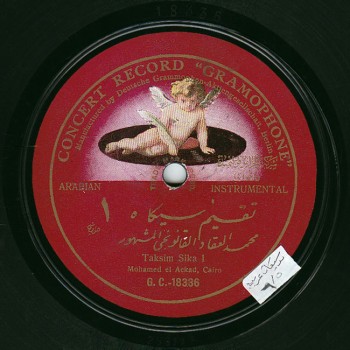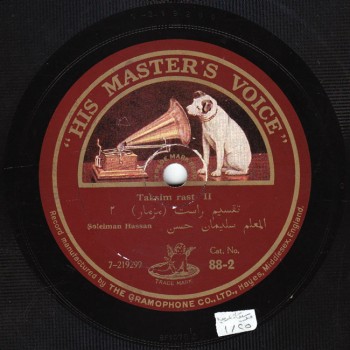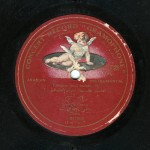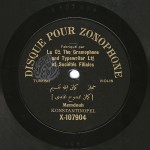The Arab Music Archiving and Research foundation (AMAR), in collaboration with the Sharjah Art Foundation (SAF), presents “Niẓāmunā al-Mūsīqī”.
Dear listeners,
Welcome to a new episode of “Niẓāmunā al-Mūsīqī”.
Today, we will resume our discussion about the taqsīm.
The position of all taqsīm types within the purely instrumental waṣla is distinctive, knowing that these waṣla already existed before the recording era, and that discs partitioned them and partitioned vocal waṣla.
It seems that the major instrumentalists and takht leaders performed some of these waṣla either in independent events/concerts –a very rare occurrence at the time– or between two vocal waṣla. Thus, the taqsīm was positioned:
- between two pieces;
- as a transition between a piece and another;
- as a taqsīm muwaqqa‘ in the taslīm from a rhythmic cycle to another.
It is difficult for an experienced musician to remember with precision a phrase he previously performed, since his concern is mainly focused on the concept and not on the phrase. Still, he states his concept and develops it in the following phrase.
As an example, let us listen to the recording of a taqsīm ṣabā performed by Amīn al-Buzarī on his nāy, where we can hear someone begging him to remember his phrase and to repeat it, which Amīn tried to do. Yet, he failed to produce the same measure, but was able to keep the same melodic concept.
We have not come across any recording of Amīn al-Buzarī accompanying a muṭrib: all his recordings are instrumental, and mostly of partitioned/sectioned instrumental waṣla following a matrix numbers’ order.
The following recording starting with a dūlāb (overture) to the ṣabā was performed by the takht of Amīn al-Buzarī (nāy) with Manṣūr ‘Awaḍ (‘ūd), Sāmī al-Shawwā (kamān), Maqṣūd Kalkadjian (qānūn), and Muḥammad Abū Kāmil (percussions), and made in 1909 by Gramophone on one side of a 30cm record, # 018011, matrix # 1695c.
(♩)
The most famous takht of the second half of the 19th century include Takht al-‘Aqqād, also known as Takht Al-Ḥāmūlī because it accompanied ‘Abduh al-Ḥāmūlī –the most famous muṭrib at the time and the leader of an innovative school, who is said to have liked listening to instrumental music. It is also said that ‘Abduh al-Ḥāmūlī was sent by Khedive Ismā‘īl along with a takht including Muḥammad al-Aqqād (qānūn), Aḥmad al-Laythī (‘ūd), Ḥasan al-Jāhil (kamān), ‘Abduh Ṣāliḥ Abū ‘Alī (nāy), and Muḥammad Abū Kāmil al-raqqāq (percussions) on a trip during which the musicians copied many instrumental works by their Turkish counterparts, and came back with numerous Arabized instrumental waṣla… We will discuss this issue in future episodes…
…In the 78rpm discs of Takht al-‘Aqqād, the ‘ūdist was not replaced after his departure, whereas the violinist was now Ibrāhīm Sahlūn, and the nāy player ‘Alī Abduh Ṣāliḥ.
These sectioned waṣla include all types of taqsīm performed by Muḥammad al-Aqqād who played the qānūn without ‘urab, which made the melodic transition from a tune to another very difficult to perform.
This example shows how Al-Aqqād performed his taqsīm without:
- making the listeners feel the need for a melodic transition;
- showing the difficulty of the modulation when he did perform a melodic transition.
Let us listen to him performing a taqsīm sikāh recorded electrically around 1912 by Gramophone on one side of a 25cm record, # 4594 30, matrix # BG 490.
(♩)
The art of taqsīm was not limited to classical music as it also existed in popular and in religious traditions. For example, if a dhikr ceremony included a nāy, the taqsīm section was then a main section repeated throughout the ceremony. This point is mentioned within the types of taqsīm muwaqqa‘, yet our subject today is the taqsīm fālit (free) or mursal.
The major popular traditions in Egypt include the mizmār (the zurnāy in some other regions) present in most regions where popular traditions follow the maqām system.
Let us listen to a taqsīm rāst performed by the master Sulaymān Ḥasan on his mizmār, recorded electrically around 1927 by His Master’s Voice –daughter company of Gramophone– on one side of a 25cm record, # 7-219299, matrix # BF 1078.
(♩)
Takht Odeon, that appeared at the beginning of the 78rpm disc’ recording era, accompanied most muṭrib who recorded with German record company Odeon, and recorded many instrumental works.
We are mentioning this takht because of a type of taqsīm, the taqsīm mushtarak (shared), that was performed within the vocal waṣla, and that was recorded in both its mursal form and its muwaqqa‘ form on full record-sides of some dawr or qaṣīda. For example, the dawr is followed by qānūn taqsīm, then by ‘ūd taqsīm.
Since our episode is about taqsīm mursal, we will present today the mursal type of the taqsīm mushtarak. Takht Odeon is the only takht that dedicated whole record-sides or whole discs to this type of taqsīm.
As an example of this type, let us listen to a taqsīm ḥijāz mushtarak performed by Takht Odeon with Ḥāj al-Sayyid al-Suwaysī (‘ūd), ‘Abd al-‘Azīz al-Qabbānī (qānūn), and ‘Alī Abduh Ṣāliḥ (nāy), recorded in 1904 by Odeon on one side of a 27cm record, # 31016, matrix # EX 951.
(♩)
Dear listeners, we have reached the end of today’s episode of “Niẓāmunā al-Mūsīqī”.
We will meet again in a new episode to discuss the different types of taqsīm.
“Niẓāmunā al-Mūsīqī” is brought to you by Mustafa Said.
- 221 – Zakariyya Ahmed – 12 (1/9/2022)
- 220 – Zakariyya Ahmed – 11 (1/9/2022)
- 219 – Zakariyya Ahmed – 10 (11/25/2021)
- 218 – Zakariyya Ahmed – 9 (10/26/2021)
- 217 – Zakariyya Ahmed – 8 (9/24/2021)
- 216 – Zakariyya Ahmed – 7 (9/4/2021)
- 215 – Zakariyya Ahmed – 6 (8/28/2021)
- 214 – Zakariyya Ahmed – 5 (8/6/2021)
- 213 – Zakariyya Ahmed – 4 (6/26/2021)
- 212 – Zakariyya Ahmed – 3 (5/27/2021)
- 211 – Zakariyya Ahmed – 2 (5/1/2021)
- 210 – Zakariyya Ahmed – 1 (4/28/2021)
- 209 – W-al-Lāhi lā astaṭī‘u ṣaddak 2 (4/6/2017)
- 208 – W-al-Lāhi lā astaṭī‘u ṣaddak 1 (3/30/2017)
- 207 – Bashraf qarah baṭāq 7 (3/23/2017)

